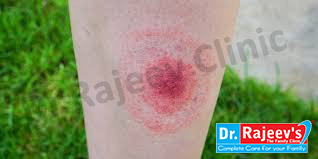Lyme disease is caused by four main species of bacteria. Borrelia burgdorferi and Borrelia mayonii . The most common tick-borne illness in these regions, Lyme disease is transmitted by the bite of an infected black-legged tick, commonly known as a deer tick.
Symptoms of Lyme disease
The signs and symptoms of Lyme disease vary. They usually appear in stages, but the stages can overlap.

Early signs and symptoms
A small, red bump, similar to the bump of a mosquito bite, often appears at the site of a tick bite or tick removal and resolves over a few days. This normal occurrence doesn't indicate Lyme disease.
However, these signs and symptoms can occur within a month after you've been infected:
-
Rash. From three to 30 days after an infected tick bite, an expanding red area might appear that sometimes clears in the center, forming a bull's-eye pattern. The rash (erythema migrans) expands slowly over days and can spread to 12 inches (30 centimeters) across. It's typically not itchy or painful but might feel warm to the touch.
Erythema migrans is one of the hallmarks of Lyme disease, although not everyone with Lyme disease develops the rash. Some people develop this rash at more than one place on their bodies.
- Other symptoms. Fever, chills, fatigue, body aches, headache, neck stiffness and swollen lymph nodes can accompany the rash.
Later signs and symptoms
If untreated, new signs and symptoms of Lyme infection might appear in the following weeks to months. These include:
- Erythema migrans. The rash may appear on other areas of your body.
- Joint pain. Bouts of severe joint pain and swelling are especially likely to affect your knees, but the pain can shift from one joint to another.
- Neurological problems. Weeks, months or even years after infection, you might develop inflammation of the membranes surrounding your brain (meningitis), temporary paralysis of one side of your face (Bell's palsy), numbness or weakness in your limbs, and impaired muscle movement.
Less common signs and symptoms
Several weeks after infection, some people develop:
- Heart problems, such as an irregular heartbeat
- Eye inflammation
- Liver inflammation (hepatitis)
- Severe fatigue
Causes of Lyme disease
In the United States, Lyme disease is caused by the bacteria Borrelia burgdorferi and Borrelia mayonii, carried primarily by black-legged or  deer ticks. Young brown ticks often are no bigger than a poppy seed, which can make them nearly impossible to spot.
deer ticks. Young brown ticks often are no bigger than a poppy seed, which can make them nearly impossible to spot.
To contract Lyme disease, an infected deer tick must bite . The bacteria enter skin through the bite and eventually make their way into bloodstream.
In most cases, to transmit Lyme disease, a deer tick must be attached for 36 to 48 hours. If you find an attached tick that looks swollen, it may have fed long enough to transmit bacteria. Removing the tick as soon as possible might prevent infection.
Risk factors
Where you live or vacation can affect your chances of getting Lyme disease. So can your profession and the outdoor activities you enjoy. The most common risk factors for Lyme disease include:
- Spending time in wooded or grassy areas. deer ticks are found mostly in the heavily wooded areas of the Northeast and Midwest. Children who spend a lot of time outdoors in these regions are especially at risk. Adults with outdoor jobs also are at increased risk.
- Having exposed skin. Ticks attach easily to bare flesh. If you're in an area where ticks are common, protect yourself and your children by wearing long sleeves and long pants. Don't allow your pets to wander in tall weeds and grasses.
- Not removing ticks promptly or properly. Bacteria from a tick bite can enter your bloodstream if the tick stays attached to your skin for 36 to 48 hours or longer. If you remove a tick within two days, your risk of getting Lyme disease is low.
Complications
Untreated Lyme disease can cause:
- Chronic joint inflammation (Lyme arthritis), particularly of the knee
- Neurological symptoms, such as facial palsy and neuropathy
- Cognitive defects, such as impaired memory
- Heart rhythm irregularities
Prevention
- Cover up. When in wooded or grassy areas, wear shoes, long pants tucked into your socks, a long-sleeved shirt, a hat and gloves. Try to stick to trails and avoid walking through low bushes and long grass.
-
Use insect repellents. Apply insect repellent with a 20% or higher concentration of DEET to your skin. Parents should apply repellant to their children, avoiding their hands, eyes and mouth.
Keep in mind that chemical repellents can be toxic, so follow directions carefully. Apply products with permethrin to clothing or buy pretreated clothing.
- Do your best to tick-proof your yard. Clear brush and leaves where ticks live. Mow your lawn regularly. Stack wood neatly in dry, sunny areas to discourage rodents that carry ticks.
-
Check your clothing, yourself, your children and your pets for ticks. Be especially vigilant after spending time in wooded or grassy areas. Deer ticks are often no bigger than the head of a pin, so you might not discover them unless you search carefully.
It's helpful to shower as soon as you come indoors. Ticks often remain on your skin for hours before attaching themselves. Showering and using a washcloth might remove unattached ticks.
- Don't assume you're immune. You can get Lyme disease more than once.
- Remove a tick as soon as possible with tweezers. Gently grasp the tick near its head or mouth. Don't squeeze or crush the tick, but pull carefully and steadily. Once you've removed the entire tick, dispose of it by putting it in alcohol or flushing it down the toilet, and apply antiseptic to the bite area.






